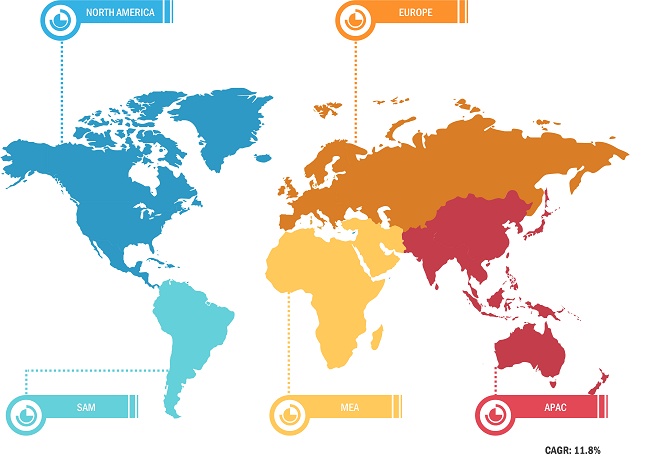Growing Demand for Organic Food Products Propels Humic Acid Market Growth
According to our new research study titled "Humic Acid Market to Forecast 2030 – COVID-19 Impact and Global Analysis – by Form and Application," the market size was valued at US$ 1,144.11 million in 2022 and is projected to reach US$ 2,640.11 million by 2030; it is expected to register a CAGR of 11.0% from 2022 to 2030.
Humic acid is an organic compound mainly found in peat, soil, coal deposits, and vermicompost. It physically modifies the soil structure, which lowers water and nutrient loss, increases the water-holding capacity, and promotes better nutrient uptake from the plant roots. This results in improved crop yield. Many farmers and horticulturists are increasingly using humic acid-based soil conditioners to obtain higher crop yields. This factor is bolstering the demand for humic acid across the agriculture and horticulture sectors.
Humic Acid Market Breakdown – by Region
Humic Acid Market Forecast to 2030 - Global Analysis by Form (Dry and Liquid), Application (Agriculture, Horticulture, Ecological Bioremediation, Dietary Supplements, and Others), and Geography
Humic Acid Market Drivers and Opportunities by 2030
Download Free Sample
According to the 2023 Organic Industry Survey conducted by the Organic Trade Association, organic food sales in the US increased to US$ 67.6 billion in 2023 from US$ 63 billion in 2022. According to the Department of Health of the State Government of Victoria, the retail value of the organic market was estimated to be at least US$ 1.58 billion in 2021. According to the IFOAM, Australia has the largest organic agricultural area (35.7 million hectares), followed by Argentina (3.6 million hectares) and China (3.1 million hectares), respectively. In addition, the sales of organic products have consistently increased over the last decades.
Organic farming practices emphasize soil health and fertility. As a natural soil amendment, humic acid enhances soil structure, improves nutrient availability, and promotes microbial activity. It helps organic farmers maintain and improve soil fertility. Organic food production requires compliance with specific standards and regulations. Organic certifying bodies often need to implement approved inputs and practices, including organic soil amendments. Humic acid, derived from organic sources, fulfills the requirements for organic certification. In addition, humic acid has been shown to improve plant growth by facilitating root development and improving stress tolerance. Organic food producers prioritize plant health and natural disease resistance by minimizing synthetic pesticides and fertilizers. The use of humic acid in organic farming contributes to the production of food that is perceived as healthier and more environmentally friendly. Thus, the growing demand for organic food products would lead to new trends in the humic acid market in the coming years.
A few of the key players operating in the humic acid market are AGBEST TECHNOLOGY CO LTD, Agriculture Solutions Inc, Black Earth Products Inc, AGRICULTURAL AND MINING DEVELOPMENT SA, Faust Bio-Agricultural Services Inc, Humic Growth Solutions Inc, Humintech GmbH, The Andersons Inc, MYCSA Ag Inc, and Grow More Inc. These players are investing in various strategies such as new product development, merger and acquisition, partnership, and expansion to expand their geographic footprint to cater to a large number of consumers.
Impact of COVID-19 Pandemic on Humic Acid Market
The COVID-19 pandemic affected economies and industries in various countries across the globe. Lockdowns, travel restrictions, and business shutdowns in North America, Europe, Asia Pacific (APAC), South & Central America (SAM), and the Middle East & Africa (MEA) hampered the growth of several industries, including the chemicals & materials industry. The shutdown of manufacturing units disturbed global supply chains, manufacturing activities, and delivery schedules. Disruptions in the global supply chains led to a significant shortage of raw materials, which hampered the production of various large-scale and small-scale humic acid manufacturers. The COVID-19 pandemic, thus, induced various economic challenges, including trade barriers and tariffs, currency fluctuations, and regulatory challenges, which hindered the humic acid market growth in different regions.
The humic acid market began reviving as governments of various countries took significant measures, such as well-coordinated vaccination drives. The resumption of agricultural and horticultural business activities, and consumers’ shift toward organic food products propelled the demand for humic acid products in 2021.
The report segments of humic acid market as follows:
Based on form, the humic acid market is segmented into dry and liquid. Based on application, the market is divided into agriculture, horticulture, ecological bioremediation, dietary supplements, and others. The humic acid market, based on geography, is segmented into North America (US, Canada, and Mexico), Europe (Germany, France, Italy, UK, Russia, and Rest of Europe), Asia Pacific (Australia, China, Japan, India, South Korea, and Rest of Asia Pacific), the Middle East & Africa (South Africa, Saudi Arabia, UAE, and Rest of Middle East & Africa), and South & Central America (Brazil, Argentina, and Rest of South & Central America). For instance, in July 2020, Black Earth Humic completed the acquisition of Canadian Humalite International with an aim to diversify its product portfolio, and to work on agriculture and applied humic innovations. After the acquisition, the company name was changed to Black Earth Products Inc. Such initiatives by the key market players are expected to drive the humic acid market industry over the forecast period.
Contact Us
Phone: +1-646-491-9876
Email Id: sales@theinsightpartners.com